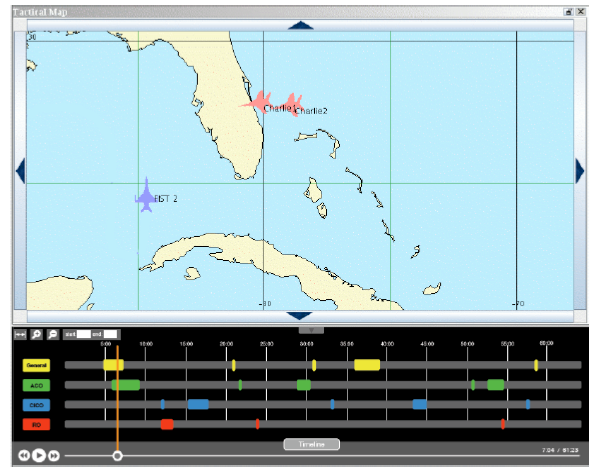Cognitive software captures experts’ performance on flight simulators
May 18, 2012

Debrief tool used in the experiment displays a video replay of the operator console (similar to this map display), and a timeline of events suggested by AEMASE for discussion during debrief. The tool also includes visualizations of entity movement over time. (Credit: S. M. Stevens-Adams et al.)
Navy pilots and other flight specialists soon will have a new “smart machine” installed in training simulators that learns from expert instructors to more efficiently train their students.
Sandia National Laboratories’ Automated Expert Modeling & Student Evaluation (AEMASE, pronounced “amaze”) is being provided to the Navy as a component of flight simulators.
Components are now being used to train Navy personnel to fly H-60 helicopters and a complete system will soon be delivered for training on the E-2C Hawkeye aircraft, said Robert G. Abbott, a Sandia computer scientist and AEMASE’s inventor. The work is sponsored by the Office of Naval Research.
AEMASE is a cognitive software application that updates its knowledge of experts’ performance on training simulators in real time to prevent training sessions from becoming obsolete and automatically evaluates student performance, both of which reduce overall training costs, Abbott said.
“AEMASE is able to adapt and is aware of what’s going on,” he said. “That’s what’s driving our cognitive modeling and automated systems that learn over time from the environment and from their interactions with people.”
Previous flight simulators have not done well with ambiguous or new situations that required time-consuming reprogramming, making it difficult for the military to adapt quickly to changing environments and tactics.
AEMASE bypasses lengthy interviews of instructors and reprogramming once the simulator is running. Instead, instructors fly the simulator themselves to capture their expertise, a feature that works particularly well in ambiguous situations where it’s difficult to program a set of explicit rules, Abbott said.
Melissa Walwanis, a senior research psychologist at the Naval Air Warfare Center’s Training System Division in Orlando, Fla., said AEMASE will give Navy trainees specific ways to improve performance through machine learning, automated performance measurement, and recordings of trainees’ voices during the training sessions.
AEMASE addresses a needle-in-a-haystack problem. Just as search engines find certain words across the Internet, AEMASE scans hundreds of training sessions to find specific actions or scenarios and makes comparisons, Abbott said.
The software is designed for context recognition. It searches until it recognizes a situation it has seen before and determines whether the students are making a desirable decision, Abbott said.
The software recognizes there may be multiple right answers that incorporate different ways of responding to the situation, Forsythe added. For example, AEMASE tracks certain flight parameters — say distance, the angle of the aircraft from the ground and velocity — to create vectors that are treated as points within a multidimensional space defined by the parameters.
Different “right” answers are expressed as points in the space, but will tend to gather in one area, while poor performance can be measured by a point’s distance from the “expert” points.
But for instructors, AEMASE’s interface is simple. They can flag actions by pushing a one-click thumbs-up button to record good behavior or a thumbs-down button when students fly too low or too close together in the simulation, Abbott said.
AEMASE places those flagged events on a timeline display, so instructors and students can review errors in recordings of student performance. Then AEMASE uses that information to recognize other instances of the errors, helping the instructors become more efficient by automatically flagging errors for them to review with other students.
These flags are the seeds for the model’s future development as scenarios and preferred actions evolve over time, Forsythe said.
AEMASE also incorporates speech recognition technology to assess how effectively teams communicate.
Sandia is adapting the software to similar training aids for computer security analysts. Potential applications include driver’s education, automating robots, and many other areas, Abbott said.